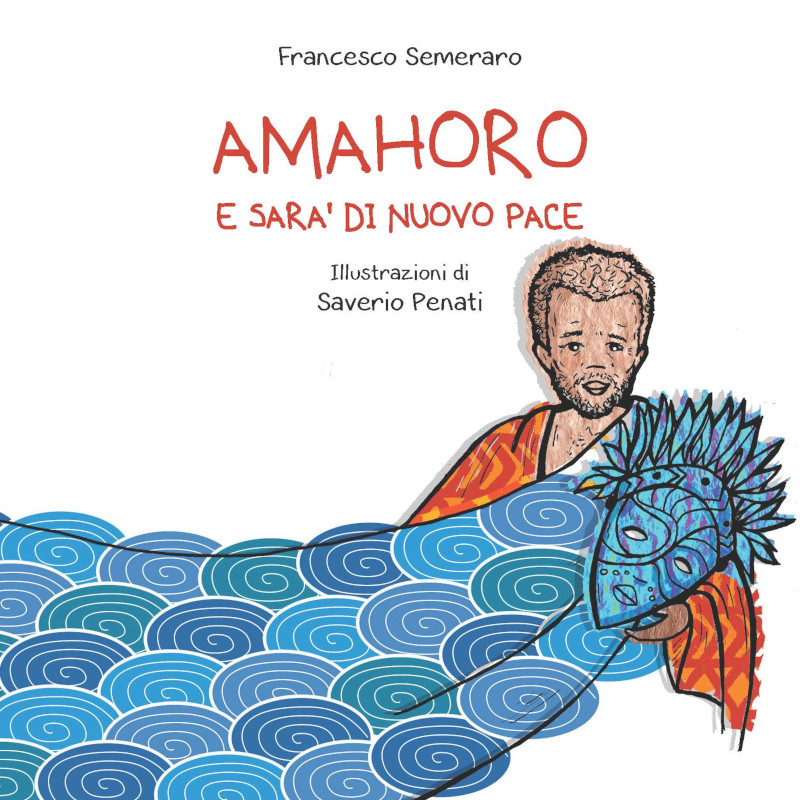
Children’s (and other) books | “Amahoro and it will be peace again”
A book to talk to children about Peace, and to learn with them that peace is made. A project for a “house of hope” in Burundi
By Francesco Semeraro
“An old Burundian fisherman told me this story…” – is the sentence printed on the back cover of the short story “Amahoro and it will be peace again”. It attracts many readers, especially children, who often ask me in curiosity if it really happened as it is written. And I answer them thus.
On my first trip to Burundi, my senses were super-active. This always happens to me when I am traveling. I enjoyed exchanging smiles with people and asking questions to satisfy my curiosity, despite not knowing the language. I felt the beats of those people’s hearts and put the smiles of the children I met everywhere in the memory box. I memorized the song of the lush nature and did not miss even a whisper of the gentle wind, which blows from the lake to the land in the evening.
Everything became a tale thanks to my daughter Chancelline – born in Burundi – who
has allowed me to become an adopted son
of this land of a thousand hills, where milk and honey flows.
Thus, the old fisherman told me about the lands bathed by Lake Tanganyika and the heights of Kasumo, where the first wanderings of the Nile River, its source, gushed forth. All the wonder I enjoyed was certainly the work of a wise god, Amazi-the father of all waters-those of heaven and those of earth. He had two sons, Ama and Horo who were his peace, and peace reigned in the world.
In Burundi, when people meet, they use the word “amahoro” to greet each other, which in their language, Kirundi, means “peace.” In short, the greeting is a wish for harmony and is also used to declare, “I come in peace.”
So, I said to myself, if Ama and Horo remain united, peace reigns. Unfortunately, it happens that pride gets in the way of two  brothers, breaking the peace and spreading hatred to the hearts of men. Thus a war breaks out between the tribe living by the lake and the tribe living on the highlands.
brothers, breaking the peace and spreading hatred to the hearts of men. Thus a war breaks out between the tribe living by the lake and the tribe living on the highlands.
The story is inspired by the conflict – unfortunately culminating in the 1994 genocide – between Hutu and Tutsi (the two largest ethnic groups inhabiting Burundi and neighboring Rwanda).
The hostility that drags on to the present day is a feeling of hatred grafted on by the European colonizers of the late 19th century; like a weed, it has taken root on pride, a malevolent legacy that is passed down from father to son. This happens when there is a tendency to emphasize differences rather than enhance the beauty and values of each.
In the story, two other characters make an appearance, with whom I became acquainted while exploring the mouth of the Rusizi River, at the point where it plunges into the immensity of Lake Tanganyika.
These are two animals, both very aggressive by nature and for different reasons; they inhabit – not peacefully – the same waters, sharing the hours of the day: the hippo as an imposing ruler in daylight and the crocodile as a devious nocturnal predator.
Both wanted to take part in the story. And how could I argue against them, given their insistence and manner? I could not help but put them at the center of the story, to the point of making them the protagonists.
The two characters are the architects of their own future and of the ending of the story, which surprises and fascinates especially young readers.
The narrative, in the style of peoples’ myths, was sublimated by the pencil of his friend Saverio Penati, an expert illustrator for children, who gave the story shape and color.
In recent years, Amahoro has also crossed the doors of primary and secondary schools,
through an intercultural and peace education project,
integrated into the institutions’ specific educational offering plans,
which are available free of charge to principals, teachers or anyone interested.
Pupils, through dynamics and interactive workshops, discovered how peacemaking is possible by overcoming individualism and closures, and although conflict sometimes seems inevitable, the determined conviction implemented to overcome personalism can work wonders.
The proceeds of the book went back to Burundi-thanks to the initiative of the 4inzu OdV Association – to finance the construction of a “Nice Hope House” where children in orphaned and distressed
find welcoming arms waiting for an encounter that can tell more stories like this one.
The experience gained in these years teaches me that there can still be hope, with the example of the youngest, because maybe thanks to them it will be Amahoro, it will be peace again!
Francesco Semeraro
Source and images
- spazio + spadoni
- Association 4inzu
- Francesco Semeraro
